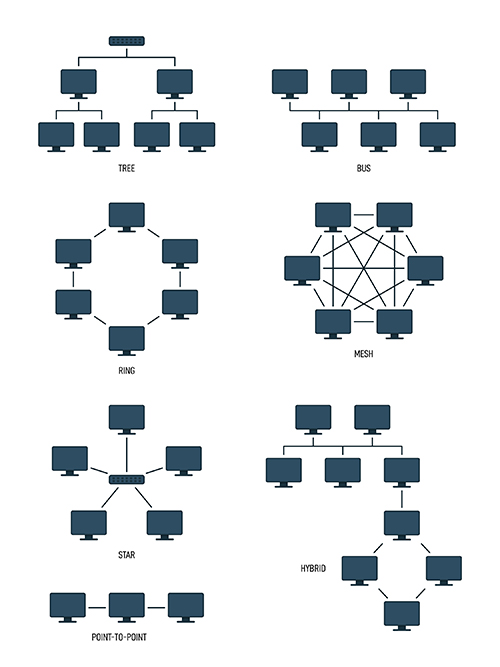Network Design: Unleashing the Power of Seamless Connectivity
Network design is the crucial foundation of a successful and efficient IT infrastructure. They require careful planning, analysis, and implementation to ensure seamless connectivity and optimal performance. Essentially, network designs are the blueprint for how your organization’s devices connect and communicate with each other and are made to suit an organization’s unique requirements.
While network designs are unique to needs, there is a basic structure to them. They include a logical map of the network, cabling structure, quantity, type, and location of all network devices, IP addressing structure, network security architecture, and all network security processes.
The Breakdown of Network Design
1. Understand Your Network – this first step is crucial since network designs are meant to meet an organization’s needs. During this step, organizations should evaluate their existing network infrastructure, components, and services running on it. Collected data should include types of WAN technologies, routing protocols, security controls, and network equipment and devices such as:
- Computers, including laptops
- Operating systems
- Software applications
- Servers
- Modems
- Routers
- Firewalls
- Stable internet connections
You may not have to include every one of these components in your network design, but they all influence how well the network works so understanding and selecting complementary components is important.
In addition, this step should lay out the goals you want for your network. These goals can include but are not limited to:
- Improving network performance metrics
- Reducing downtime
- Upgrading to the latest technologies
- Improving network security
- Simplifying network management
- Improve network availability
When taking the time to truly understand an organization’s network it is crucial to understand the possible constraints. The most common constraint when it comes to network design is budget. This is because the budget impacts your resources like the equipment an organization can even afford. Once constraints are addressed, organizations can create a more accurate budget for network design. Other common constraints can be limitations with cabling, WiFi, or strict security and compliance requirements.
2. Decide on Network Topology – this is your floor plan for connectivity and comes in several variations:
- Point to Point – this is the simplest topology where there is one dedicated link between two endpoints
- Star – the most common topology is laid out, so every device is connected to a central hub or switch
- Bus – all devices are connected on one single line running in one single direction
- Ring – all devices are connected in a circular path running in one direction or both directions with each device having two neighbors
- Dual ring – the same as Ring but with an added second connection
- Tree – a combination of star and bus, this topology has a parent-child hierarchy to how devices are connected
- Mesh – an intricate structure of point-to-point connections where the devices interconnect
- Hybrid – a combination of two or more topology structures e.g., tree topology

The concept of topology can also be broken down into two separate categories: physical, referring to the actual connections of how the network is arranged, and logical, referring to an idea of how the network is set up including which nodes connect and how data is transmitted through the network.
3. Outline Network Connections – this step is pretty straightforward and is ideal for giving a visual of what an organization’s network is by creating a diagram that shows the connections. To avoid any connection errors, it is possible to outsource and have experts create these diagrams or just review them. This diagram also verifies the true size of the network and should include devices that demand bandwidth including computers, VoIP phones, servers, printers, and IoT devices. This visual should also note the exact location of endpoints, how many there are, and the locations of any common work areas and Wi-Fi-connected devices.
4. Never Skip Security – creating and implementing a network design would be almost pointless without the security it needs to run efficiently. Some best practices for network design security include:
- Installing firewalls, anti-virus, or some type of security tool
- Revisiting and communicating security policies
- Performing regular network audits
- Using private IP addresses
- Establishing network security maintenance systems
- Encrypting critical data
- Employing multi-factor authentication
- Backing up data and having recovery plans
- Encouraging employees to create strong passwords and use better password practices
5. Prepare for change – business and technology are ever-changing, this is why when an organization is creating its network design there should be room for change. The size and scope of a business and its network can change at any time so building in some degree of flexibility in the design will allow growth when needed. This growth can include adopting new technologies, location expansion, and increasing products, services, or number of employees. Looking into current infrastructure also gives businesses the ability to better outline hardware, software, or bandwidth that would potentially be needed.
6. Develop a strategy – once the network is mapped out and the design is set, implementing the plan is next. There are a few steps one can take to flawlessly implement the network design including:
- Consider a phased implementation approach, this is particularly useful for organizations with more complex networks
- Set up a controlled testing environment and test before deployment to identify any weaknesses, ensuring a reliable and secure network design when it goes live
- Implement any changes to processes needed and train employees
- Continuously monitor performance regularly to help ensure optimal performance, and pay extra attention to performance metrics so that any problems can be identified and addressed quickly
- Once the network has been designed and deployed, maintenance should be done regularly to keep any problems from arising
The Takeaway
A well-planned network design gives organizations the competitive edge to evolve with technology and their changing business needs, safeguard their data, and continuously offer their services effectively. By carefully planning and implementing a network that meets a business’s overall needs and goals, they can see improved productivity, better collaboration, seamless data transfer, and reduced operational costs aiding businesses to stay on the path of growth and longevity.


